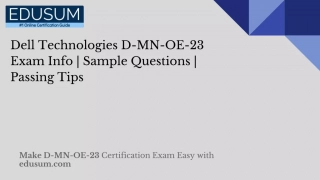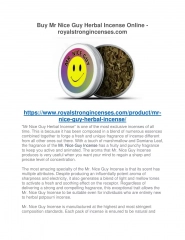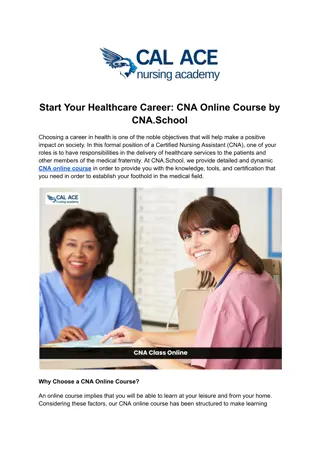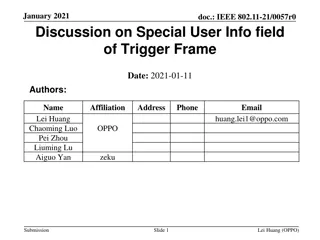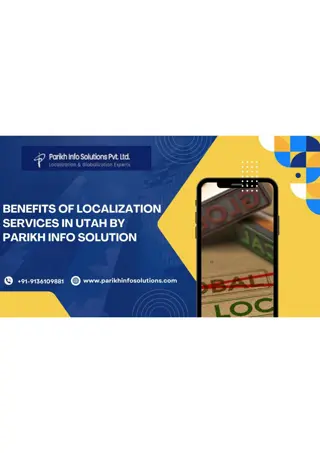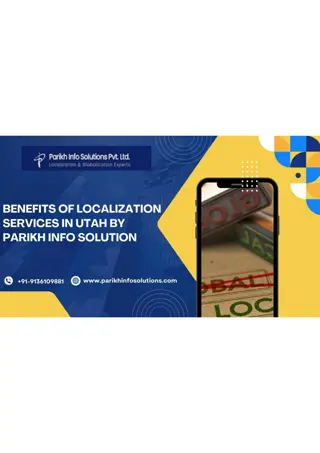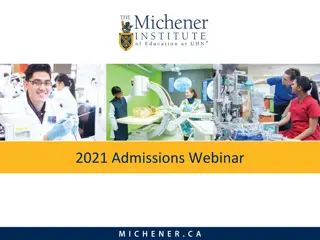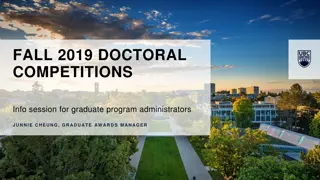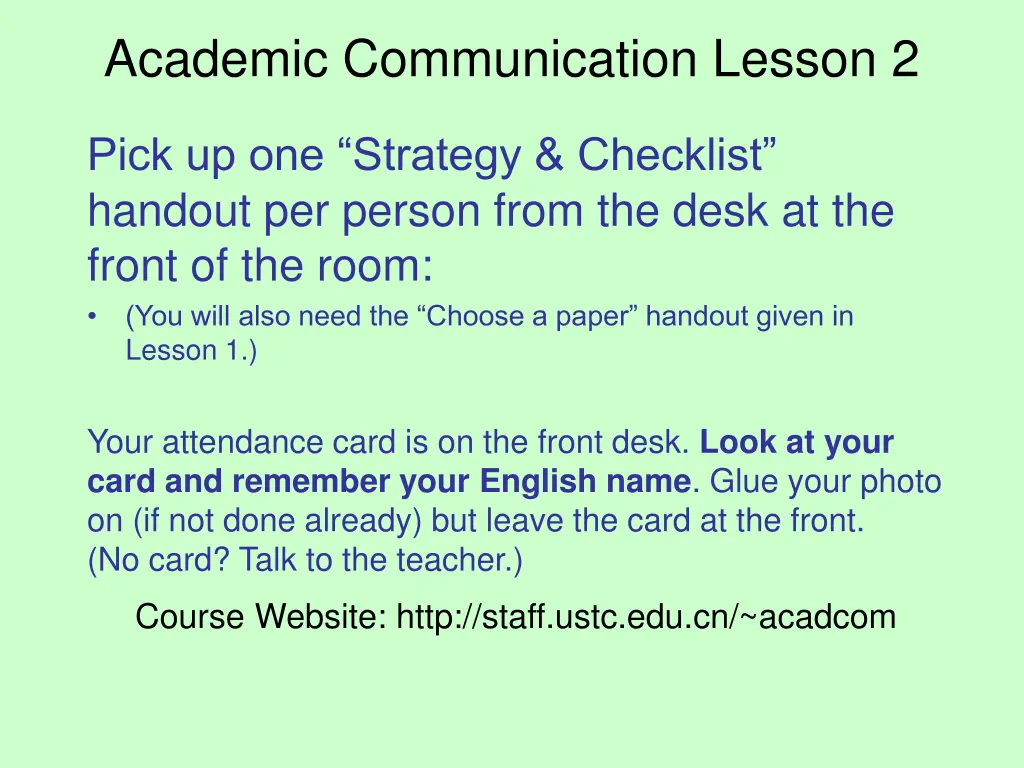
Academic Communication Lesson 2: Strategies and Checklists for Scientific Presentations
Enhance your scientific presentation skills with strategies, checklists, and essential guidelines provided in Academic Communication Lesson 2. Explore how to choose a paper, analyze your audience, and meet the purpose of your talk effectively for academic success.
Download Presentation

Please find below an Image/Link to download the presentation.
The content on the website is provided AS IS for your information and personal use only. It may not be sold, licensed, or shared on other websites without obtaining consent from the author. If you encounter any issues during the download, it is possible that the publisher has removed the file from their server.
You are allowed to download the files provided on this website for personal or commercial use, subject to the condition that they are used lawfully. All files are the property of their respective owners.
The content on the website is provided AS IS for your information and personal use only. It may not be sold, licensed, or shared on other websites without obtaining consent from the author.
E N D
Presentation Transcript
Academic Communication Lesson 2 Pick up one Strategy & Checklist handout per person from the desk at the front of the room: (You will also need the Choose a paper handout given in Lesson 1.) Your attendance card is on the front desk. Look at your card and remember your English name. Glue your photo on (if not done already) but leave the card at the front. (No card? Talk to the teacher.) Course Website: http://staff.ustc.edu.cn/~acadcom
Course Goals 1. Good speakers will get better 2. Bad speakers will get good enough (to present scientific results in English at an international conference) 3. You will know what to aim for (i.e., what you are trying to do) 4. You will know what mistakes to avoid
With your partner, make 2 lists What makes a good scientific presentation good? Clear organization What makes a bad scientific presentation bad? Bad pronunciation
Presentation Checklist Two uses: Gives you a step-by-step plan to follow Makes sure you do not miss anything important
Section 1: Determine basic parameters A. Choose a subject. [This may be all or part of the paper to be presented.] B. Analyze your listeners. C. Analyze the purpose of the talk.
Choose a paper to present for your Final Exam in this course See information on handout given in Lesson 1. Basically: Paper/result must be <6 years old Result must be significant, specific, and new Significant enough to be worth presenting at a conference NOT a general, basic introduction to your area NOT known before the paper was published NOT a review of previously published results Published or unpublished, your result or somebody else s result, written in Chinese or English (needs English abstract)
Section 1: Determine basic parameters A. Choose a subject. [This may be all or part of the paper to be presented.] = Your homework: Chose a paper to present B. Analyze your listeners. C. Analyze the purpose of the talk.
Section 1: Determine basic parameters A. Choose a subject. [This may be all or part of the paper to be presented.] = Your homework: Chose a paper to present B. Analyze your listeners. Done in Lesson 1 of this course: Graduate level scientists, probably in different area and/or field C. Analyze the purpose of the talk.
Section 1: Determine basic parameters A. Choose a subject. [This may be all or part of the paper to be presented.] = Your homework: Chose a paper to present B. Analyze your listeners. Done in Lesson 1 of this course: Graduate level scientists, probably in different area and/or field C. Analyze the purpose of the talk. Done in Lesson 1: Prove that you can present a research result well in English
During the Break Glue an ID photo onto your attendance card if you did not do it last week. (If you do not have a photo with you today then bring one next week, BUT you must still hand your card in today.)
Section 1D: Central Idea Write a clear statement of your central idea. One sentence 20 to 40 words long Be specific for this talk (NOT Introduce my result. That is BAD!!) What is the research result you will focus on? What should listeners get from the talk? Good: objective, quantitative data like numbers Bad: qualitative, subjective words like big , good May (or may not) include technical terms you will define in your talk
Central Idea Examples: Typical language students can reduce their accent in a second language 50% faster by using a computer which displays their voice pitch and stress in real time. (Good, can be used anywhere in Introduction) Sleator and Tarjan s splay tree data structure can be extended to k-ary search trees in a way that is provably statically optimal and probably dynamically optimal. (Good but can only be used after technical terms are defined, e.g. at end of Introduction.)
Section 1E: General Format For this course, it must be computer projection. Why? Because that s what almost all modern conferences expect. For other types of talks, it can vary Speech only (no visual aids), Lecture with blackboard, You are free to choose any presentation software Most people use PowerPoint (or a clone) because it is easy to use with many convenient options Mathematicians and physicists often use PDF Presenter view because it formats math so well.
Professional Terminology It is not enough to be an expert; You must also sound like an expert! Vocabulary, pronunciation, usage, etc. Consider, for example, syllable stress
Syllable Stress Syllable stress: important for recognizing the word syll-a-ble syll-a-ble A common problem in student presentations! Which is correct? im-age or i-mage ? Answer: im-age the a pronounced as [ ] uh not [ei] like way Which is correct? par-a-me-ter or pa-ram-e-ter ? syll-a-ble syll-a-ble
Syllable Stress mech-a-nism? mech-a-nism? me-chan-ism? mech-a-nism? Answer: mech-a-nism (noun) Similar words with different stress: me-chan-ics (noun) me-chan-i-cal (adjective) mech-a-nist-tic (adjective)
Your Personal Dictionary A. Write out 10 important terms (1, 2, or more words per term ) used often in your research area [5 minutes to write out the list] Most terms will have 3 or more syllables Underline the stressed syllables (Remember the problems with image & mechanism !) Examples: algorithmic complexity , Kolmogorov , parameter , proof by contradiction , derivative B. Partners take turns saying the terms out loud Pronounce problem sounds well (e.g., th , r-l-n) Use the right syllable stress smoothly and fluently. Speak confidently to your partner!
Homework Choose a paper for your final exam, as explained in the Lesson 1 handout Homework for Lesson 3 . Bring your paper to class next week! (We will use it in Lesson 3.) Be sure I have your attendance card before you leave today. Do NOT take your card with you! Even if you do not have a photo on it yet, I need to have your card NOW.

